|
mutLBSgeneDB |
| |
| |
| |
| |
| |
| |
|
| Gene summary for FLT3 |
 Gene summary Gene summary |
| Basic gene Info. | Gene symbol | FLT3 |
| Gene name | fms-related tyrosine kinase 3 | |
| Synonyms | CD135|FLK-2|FLK2|STK1 | |
| Cytomap | UCSC genome browser: 13q12 | |
| Type of gene | protein-coding | |
| RefGenes | NM_004119.2, | |
| Description | CD135 antigenFL cytokine receptorSTK-1fetal liver kinase 2fms-like tyrosine kinase 3growth factor receptor tyrosine kinase type IIIreceptor-type tyrosine-protein kinase FLT3stem cell tyrosine kinase 1 | |
| Modification date | 20141222 | |
| dbXrefs | MIM : 136351 | |
| HGNC : HGNC | ||
| Ensembl : ENSG00000122025 | ||
| HPRD : 00635 | ||
| Vega : OTTHUMG00000016646 | ||
| Protein | UniProt: P36888 go to UniProt's Cross Reference DB Table | |
| Expression | CleanEX: HS_FLT3 | |
| BioGPS: 2322 | ||
| Pathway | NCI Pathway Interaction Database: FLT3 | |
| KEGG: FLT3 | ||
| REACTOME: FLT3 | ||
| Pathway Commons: FLT3 | ||
| Context | iHOP: FLT3 | |
| ligand binding site mutation search in PubMed: FLT3 | ||
| UCL Cancer Institute: FLT3 | ||
| Assigned class in mutLBSgeneDB | A: This gene has a literature evidence and it belongs to targetable_mutLBSgenes. | |
| References showing study about ligand binding site mutation for FLT3. | 1. "Ishiko J, Mizuki M, Matsumura I, Shibayama H, Sugahara H, Scholz G, Serve H, Kanakura Y. Roles of tyrosine residues 845, 892 and 922 in constitutive activation of murine FLT3 kinase domain mutant. Oncogene. 2005 Dec 8;24(55):8144-53. PubMed PMID: 16091740." 16091740 2. "Vempati S, Reindl C, Wolf U, Kern R, Petropoulos K, Naidu VM, Buske C,Hiddemann W, Kohl TM, Spiekermann K. Transformation by oncogenic mutants and ligand-dependent activation of FLT3 wild-type requires the tyrosine residues 589 and 591. Clin Cancer Res. 2008 Jul 15;14(14):4437-45. doi: 10.1158/1078-0432.CCR-07-1873. PubMed PMID: 18628457." 18628457 | |
 Gene ontology having evidence of Inferred from Direct Assay (IDA) from Entrez Gene ontology having evidence of Inferred from Direct Assay (IDA) from Entrez |
| GO ID | GO Term | PubMed ID | GO:0030097 | hemopoiesis | 7507245 |
| Top |
| Ligand binding site mutations for FLT3 |
 Lollipop-style diagram of mutations at LBS in amino-acid sequence. Lollipop-style diagram of mutations at LBS in amino-acid sequence. We represented ligand binding site mutations only. (You can see big image via clicking.) |
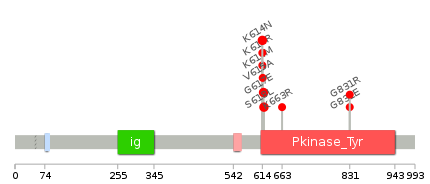 |
 Cancer type specific mutLBS sorted by frequency Cancer type specific mutLBS sorted by frequency |
| LBS | AAchange of nsSNV | Cancer type | # samples | L616 | S618L | SKCM | 2 | L616 | G617E | SKCM | 2 | M664 | K663R | COAD | 1 | L616 | K614N | COAD | 1 | L616 | K614R | COAD | 1 | F830 | G831R | COAD | 1 | F830 | G831E | COAD | 1 | L616 | K614M | COAD | 1 | L616 | K614N | LUSC | 1 | L616 | V615A | OV | 1 |
| cf) Cancer type abbreviation. BLCA: Bladder urothelial carcinoma, BRCA: Breast invasive carcinoma, CESC: Cervical squamous cell carcinoma and endocervical adenocarcinoma, COAD: Colon adenocarcinoma, GBM: Glioblastoma multiforme, LGG: Brain lower grade glioma, HNSC: Head and neck squamous cell carcinoma, KICH: Kidney chromophobe, KIRC: Kidney renal clear cell carcinoma, KIRP: Kidney renal papillary cell carcinoma, LAML: Acute myeloid leukemia, LUAD: Lung adenocarcinoma, LUSC: Lung squamous cell carcinoma, OV: Ovarian serous cystadenocarcinoma, PAAD: Pancreatic adenocarcinoma, PRAD: Prostate adenocarcinoma, SKCM: Skin cutaneous melanoma, STAD: Stomach adenocarcinoma, THCA: Thyroid carcinoma, UCEC: Uterine corpus endometrial carcinoma. |
 Clinical information for FLT3 from My Cancer Genome. Clinical information for FLT3 from My Cancer Genome. |
| Fms-related tyrosine kinase 3 (FLT3) is a gene that encodes for a tyrosine kinase that activates pathways in hematopoietic cells (Gene 2013) important in cellular proliferation. The FLT3 protein has an extracellular domain consisting of five immunoglobulin-like domains, a transmembrane domain, a juxtamembrane domain, and two tyrosine kinase domains (Figure 1; Leung, Man, and Kwong 2013). FLT3 is frequently mutated in acute myeloid leukemia, myelodysplastic syndromes, other hematologic malignancies, and colorectal cancer (COSMIC). Mutations in MDS are skewed towards the highest risk disease (refractory anemia with excess blasts). Related Pathways: Receptor tyrosine kinase/growth factor signaling.Wheeler, S., Seegmiller, A., Vnencak-Jones, C.L., Strickland, S.A., Kim, A.S. 2015. FLT3. My Cancer Genome https://www.mycancergenome.org/content/gene/flt3/ (Updated December 2015) |
| Top |
| Protein structure related information for FLT3 |
 Relative protein structure stability change (ΔΔE) using Mupro 1.1 Relative protein structure stability change (ΔΔE) using Mupro 1.1 Mupro score denotes assessment of the effect of mutations on thermodynamic stability. (ΔΔE<0: mutation decreases stability, ΔΔE>0: mutation increases stability) |
 : nsSNV at non-LBS : nsSNV at non-LBS : nsSNV at LBS : nsSNV at LBS |
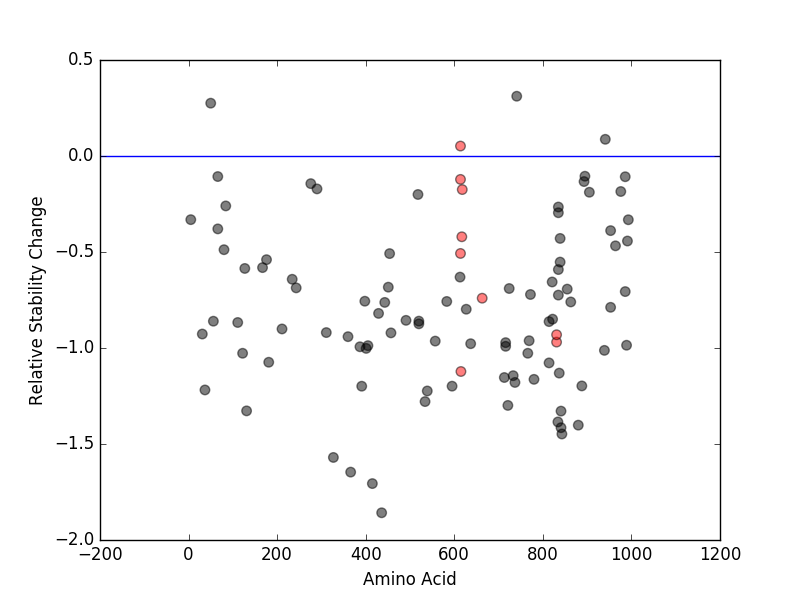 |
 nsSNVs sorted by the relative stability change of protein structure by each mutation nsSNVs sorted by the relative stability change of protein structure by each mutation Blue: mutations of positive stability change. and red : the most recurrent mutation for this gene. |
| LBS | AAchange of nsSNV | Relative stability change | L616 | K614M | 0.051811804 | L616 | V615A | -1.1223933 | F830 | G831R | -0.96922364 | F830 | G831E | -0.93091164 | M664 | K663R | -0.74058857 | L616 | K614N | -0.50753463 | L616 | G617E | -0.42071632 | L616 | S618L | -0.17483282 | L616 | K614R | -0.12184434 |
| (MuPro1.1: Jianlin Cheng et al., Prediction of Protein Stability Changes for Single-Site Mutations Using Support Vector Machines, PROTEINS: Structure, Function, and Bioinformatics. 2006, 62:1125-1132) |
 Structure image for FLT3 from PDB Structure image for FLT3 from PDB |
| PDB ID | PDB title | PDB structure | 1RJB | Crystal Structure of FLT3 |  |
| Top |
| Differential gene expression and gene-gene network for FLT3 |
 Differential gene expression between mutated and non-mutated LBS samples in all 16 major cancer types Differential gene expression between mutated and non-mutated LBS samples in all 16 major cancer types |
 Differential co-expressed gene network based on protein-protein interaction data (CePIN) Differential co-expressed gene network based on protein-protein interaction data (CePIN) |
| Top |
| Top |
| Phenotype information for FLT3 |
 Gene level disease information (DisGeNet) Gene level disease information (DisGeNet) |
| Disease ID | Disease name | # PubMed | Association type |
| umls:C0023467 | Leukemia, Myeloid, Acute | 653 | AlteredExpression, Biomarker, GeneticVariation, PostTranslationalModification |
| umls:C0023487 | Leukemia, Promyelocytic, Acute | 45 | Biomarker, GeneticVariation |
| umls:C0023449 | ACUTE LYMPHOCYTIC LEUKEMIA | 38 | Biomarker, GeneticVariation |
| umls:C0040053 | Thrombosis | 1 | Biomarker |
 Mutation level pathogenic information (ClinVar annotation) Mutation level pathogenic information (ClinVar annotation) |
| Allele ID | AA change | Clinical significance | Origin | Phenotype IDs |
| Top |
| Pharmacological information for FLT3 |
 Gene expression profile of anticancer drug treated cell-lines (CCLE) Gene expression profile of anticancer drug treated cell-lines (CCLE)Heatmap showing the correlation between gene expression and drug response across all the cell-lines. We chose the top 20 among 138 drugs.We used Pearson's correlation coefficient. |
 |
 Gene-centered drug-gene interaction network Gene-centered drug-gene interaction network |
 |
 Drug information targeting mutLBSgene (Approved drugs only) Drug information targeting mutLBSgene (Approved drugs only) |
| Drug status | DrugBank ID | Name | Type | Drug structure |
| Approved|investigational | DB00398 | Sorafenib | Small molecule | 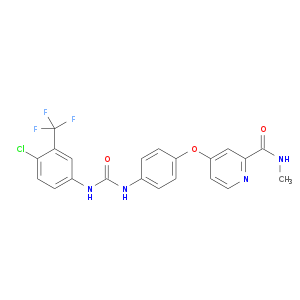 |
| Approved|investigational | DB01268 | Sunitinib | Small molecule | 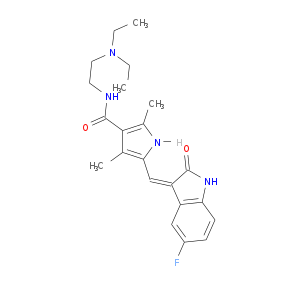 |
| Investigational | DB05014 | XL999 | Small molecule |  |
| Investigational | DB05213 | AC220 | Small molecule |  |
| Investigational | DB05216 | MP470 | Small molecule |  |
| Investigational | DB05465 | MLN-518 | Small molecule |  |
| Investigational | DB06080 | ABT-869 | Small molecule |  |
| Approved | DB08901 | Ponatinib | Small molecule | 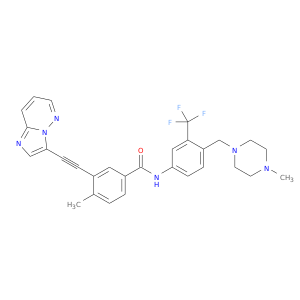 |
| Approved | DB09079 | Nintedanib | Small molecule |  |
 Gene-centered ligand-gene interaction network Gene-centered ligand-gene interaction network |
 |
 Ligands binding to mutated ligand binding site of FLT3 go to BioLip Ligands binding to mutated ligand binding site of FLT3 go to BioLip |
| Ligand ID | Ligand short name | Ligand long name | PDB ID | PDB name | mutLBS | P30 | QUIZARTINIB, PLX3397 | 1-(5-TERT-BUTYL-1,2-OXAZOL-3-YL)-3-(4-{7-[2-(MORPHOLIN- 4-YL)ETHOXY]IMIDAZO[2,1-B][1,3]BENZOTHIAZOL-2- YL}PHENYL)UREA | 4rt7 | A | L616 F830 | P30 | QUIZARTINIB, PLX3397 | 1-(5-TERT-BUTYL-1,2-OXAZOL-3-YL)-3-(4-{7-[2-(MORPHOLIN- 4-YL)ETHOXY]IMIDAZO[2,1-B][1,3]BENZOTHIAZOL-2- YL}PHENYL)UREA | 4xuf | A | L616 M664 F830 | P30 | QUIZARTINIB, PLX3397 | 1-(5-TERT-BUTYL-1,2-OXAZOL-3-YL)-3-(4-{7-[2-(MORPHOLIN- 4-YL)ETHOXY]IMIDAZO[2,1-B][1,3]BENZOTHIAZOL-2- YL}PHENYL)UREA | 4xuf | B | L616 M664 F830 |
| Top |
| Conservation information for LBS of FLT3 |
 Multiple alignments for P36888 in multiple species Multiple alignments for P36888 in multiple species |
| LBS | AA sequence | # species | Species |
 |
Copyright © 2016-Present - The University of Texas Health Science Center at Houston |
